
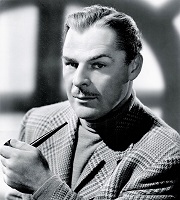 “Yeah, danger is my assignment–I get sent to a lot of places I can’t even pronounce.
“Yeah, danger is my assignment–I get sent to a lot of places I can’t even pronounce. Dangerous Assignment (1949-53) aired “Syria–Grab James C. Stoller” on June 24, 1953. Since this is only the fourth episode we have offered of Dangerous Assignment and the first in six months, a reprise of its background is in order for newcomers to the series. The show debuted on the NBC network in July of 1949 as a summer replacement and ceased in August after 7 episodes. It was popular enough with listeners and was picked up in February of 1950 to begin its almost 4-year run. It starred popular Hollywood actor Brian Donlevy (1910-1972, photo at right) as secret agent Steve Mitchell, who was sent as an undercover foreign correspondent by an unnamed U. S. State Department agency on delicate assignments abroad where U. S. interests were involved. His only “agency” contact was “the commissioner,” who would read him in on the background of the situation and then send him off to various hotspots around the globe to rectify the situation. He was rather like an early James Bond character, but much more low-key and without all the gadgets, though the situations were very much in line with some of the problems a Bond character might face.
Dangerous Assignment proved popular enough (and through the savvy management of Donlevy himself) that it was given a television show that ran from late 1951 until May of 1952 and comprised 39 episodesf. Donlevy himself led quite an interesting life with several SF genre connections, about which more in a moment. For his role as Sergeant Markoff in 1939’s Beau Geste he was nominated for a Best Supporting Acting Oscar, but lost. His career spanned the decades of the 1930s-1960s in both motion pictures (over 80 films), and television, where he played both good and bad characters in numerous popular shows. As to Donlevy’s pre-radio and film careers, in 1916 he answered the Wisconsin Army National Guard’s call to join the Pancho Villa Expedition, and though he was only 14 and lied about his age, he was accepted and served as a bugler. And during World War I he ended up in France with Company C, 127th Infantry Regiment, which was a part of the 32nd Infantry Division.
 As to Donlevy
As to Donlevy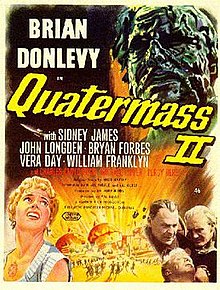 ‘s SF connections, there are two worthy of interest. He played the lead role of Professor Bernard Quatermass in the 1955 British film The Quatermass Xperiment (retitled as The Creeping Unknown in the U. S.), then reprised his role as Professor Quatermass in the 1957 British sequel Quatermass 2 (retitled as Enemy from Space in the U. S., poster at left). As to his second genre connection of note, it has to do with iconic early horror actor Bela Lugosi (1882-1956). It would seem that our Bela was either a ladies man or had trouble keeping them, for he was married five times. The total elapsed time of his marriage to four of his wives was a mere 8 years. The marriage to his fourth wife, however, was to be for 20 years to Lillian Arch. Lillian Arch (1911-1981) was 19 when they married, Bela was 51. They remained married from 1933-1953, at which time they divorced. A partial reason given for the divorce was Bela’s jealousy of Lillian’s close friendship with none other than Brian Donlevy, with whom Lillian worked on both the radio and television programs as a full-time assistant. Bela’s jealousy, warranted or not, ten years after Bela’s death in 1956, Brian would marry Lillian, the fourth ex-Mrs. Bela Lugosi. They would remain married until Donlevy’s death in 1972.
‘s SF connections, there are two worthy of interest. He played the lead role of Professor Bernard Quatermass in the 1955 British film The Quatermass Xperiment (retitled as The Creeping Unknown in the U. S.), then reprised his role as Professor Quatermass in the 1957 British sequel Quatermass 2 (retitled as Enemy from Space in the U. S., poster at left). As to his second genre connection of note, it has to do with iconic early horror actor Bela Lugosi (1882-1956). It would seem that our Bela was either a ladies man or had trouble keeping them, for he was married five times. The total elapsed time of his marriage to four of his wives was a mere 8 years. The marriage to his fourth wife, however, was to be for 20 years to Lillian Arch. Lillian Arch (1911-1981) was 19 when they married, Bela was 51. They remained married from 1933-1953, at which time they divorced. A partial reason given for the divorce was Bela’s jealousy of Lillian’s close friendship with none other than Brian Donlevy, with whom Lillian worked on both the radio and television programs as a full-time assistant. Bela’s jealousy, warranted or not, ten years after Bela’s death in 1956, Brian would marry Lillian, the fourth ex-Mrs. Bela Lugosi. They would remain married until Donlevy’s death in 1972.
This episode takes undercover agent Steve Mitchell to the troubled hotspot of Syria, Damascus to be precise, to capture the murderous traitor James C. Stoller. It turns into a perilous desert chase amongst crumbling ruins thousands of years old and ends in dramatic fashion, fulfilling the program’s promise of a truly dangerous assignment!
Play Time: 24:45
{A hot afternoon in June of 1953 found the neighborhood gang sweaty and tired after playing baseball all day, but not tired enough to miss the short walk to the new drugstore where they could quench their thirst with an ice cold fountain coke after buying a few of their favorite SF magazines. Future Science Fiction (1950-54) didn’t enjoy the longest track record in the world at only 4 years, but managed some top flight fiction nonetheless, witness William Tenn’s classic story “The Liberation of Earth.” Future SF was bi-monthly in 1953. It could be argued that Galaxy (1950-80) was entering a mini-golden age in 1953. Less than 3 years old at this point, it nevertheless had grown its audience enough to support a monthly schedule and begin to offer its own view of what was acceptable material for science fiction to explore. Universe SF (1953-58) was another of Raymond Palmer’s ventures and went through a numer of changes in its brief existence, one of which was its title. It began as Universe SF (first issue below) but after its March 1955 issue would be known as Other Worlds, the familiar title continuing the earlier version of Other Worlds which was discontinued in July of 1953. But it would change its name one more time with the November 1957 issue to Flying Saucers from Other Worlds. The title would stick for 5 more issues until the magazine folded in December of 1958. It never managed a regular schedule throughout its existence and the triple name change, but did manage to run some high quality material such as the now-classic cover story by Theodore Sturgeon “The World Well Lost,” not to mention fiction by the likes of the other big names on this issues cover.}
[Left: Future SF, May 1953 – Center: Galaxy SF, June 1953 – Right: Universe SF, June 1953]
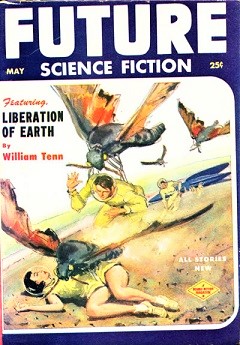
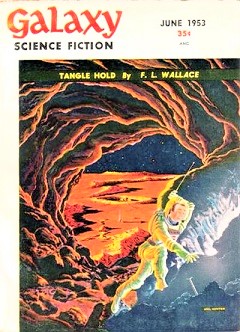
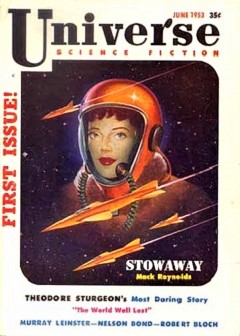
To view the entire list of weekly Old Time Radio episodes at Tangent Online, click here.